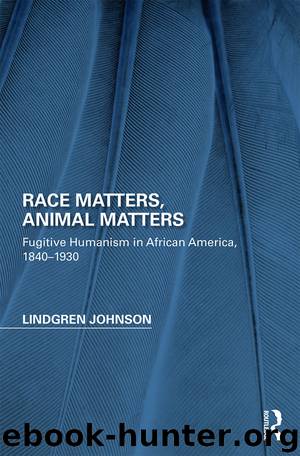Race Matters, Animal Matters by Johnson Lindgren;

Author:Johnson, Lindgren;
Language: eng
Format: epub
Publisher: Taylor & Francis Group
“Dave’s Neckliss” poignantly portrays this impasse between description and experience through and in its layered and conflated, yet disconnected presentation of flesh and bodies—of pain—both animal and human, unseen and unheard. What does it mean to stand in the presence of an eerily absent, but utterly profound violence? Does the phenomenology of Dave’s death in the smokehouse—and the hog’s in the slaughterhouse—elude us, as it seems to elude him?
It would be easy, because it is would be so familiar, to read Julius’ removal of Dave’s body from the smokehouse only as a triumphant recovery of his humanity, a corrective to Dave’s ontological confusion and a neat taxonomical tidying, with everything and everyone put back—very progressively—“in place”: after all, hams, not humans, “belong” in the smokehouse. The framing of Julius’ tale, in fact, only seems to corroborate such maneuvers. John and his wife, Annie, make the bold move of inviting Julius, at the beginning of the story, into their home to share a ham, which we watch him consume voraciously (he eats six slices) before he begins his narration. And, as a result of his narration, Julius “wins” the meat, replacing Dave’s dispossession of himself as “ham” with his own consumption and ultimate possession of ham, ergo his own humanity. In fact, it could easily be argued that it is over meat—and its more equitable distribution—that racial dialogue and reconciliation occur in their least segregated form in Chesnutt’s collection.8
Initially rendered speechless (as is John) by Julius’ story, Annie, however, has something to say the next day. So moved by Julius’ story of the destruction of Dave’s body and mind, Annie “confesses” to John something about her own: “The fact is I couldn’t have eaten any more of that ham, and so I gave it to Julius” (135). It is impossible to say unequivocally what Annie senses in this particular ham (more on this in just a moment)—the animal, the human, or both—but, in a rare occurrence, it is now she, and neither John nor Julius, who has the last words. But it is not simply the final possession of words here (as perhaps it was in “Tobe’s Tribulations”), but their embeddedness in the body, which authorizes this statement and should garner our attention. Annie articulates a somatic revelation in her words that reflects not only her own but others’ sentience—one that has changed her “taste,” making the once appealing ham unappetizing, as it now reflects others’ pain and death and not her own desire. Whatever body she identifies within the ham—and with whom she identifies—she refuses to appropriate it by consuming it and, quite literally, turning it into her own body. Her identification does not allow for and adamantly and vocally denies this specific appropriation, as she gives up her usual, exclusively figurative reading of metamorphosis.9
It would be facile and forced to argue that “Dave’s Neckliss” is a story that ends with Annie’s permanent conversion to something even resembling vegetarianism; what is much more certain is Julius’ adamant carnivorism. Not to
Download
This site does not store any files on its server. We only index and link to content provided by other sites. Please contact the content providers to delete copyright contents if any and email us, we'll remove relevant links or contents immediately.
| General | Discrimination & Racism |
Nudge - Improving Decisions about Health, Wealth, and Happiness by Thaler Sunstein(7210)
iGen by Jean M. Twenge(5135)
The Fire Next Time by James Baldwin(4998)
Adulting by Kelly Williams Brown(4208)
The Hacking of the American Mind by Robert H. Lustig(4064)
The Sports Rules Book by Human Kinetics(4057)
The Ethical Slut by Janet W. Hardy(4019)
Captivate by Vanessa Van Edwards(3705)
Mummy Knew by Lisa James(3507)
In a Sunburned Country by Bill Bryson(3344)
The Worm at the Core by Sheldon Solomon(3306)
Ants Among Elephants by Sujatha Gidla(3270)
Suicide: A Study in Sociology by Emile Durkheim(2891)
The Slow Fix: Solve Problems, Work Smarter, and Live Better In a World Addicted to Speed by Carl Honore(2827)
The 48 laws of power by Robert Greene & Joost Elffers(2762)
Humans of New York by Brandon Stanton(2669)
Handbook of Forensic Sociology and Psychology by Stephen J. Morewitz & Mark L. Goldstein(2594)
The Happy Hooker by Xaviera Hollander(2568)
The Tipping Point by Malcolm Gladwell(2535)
